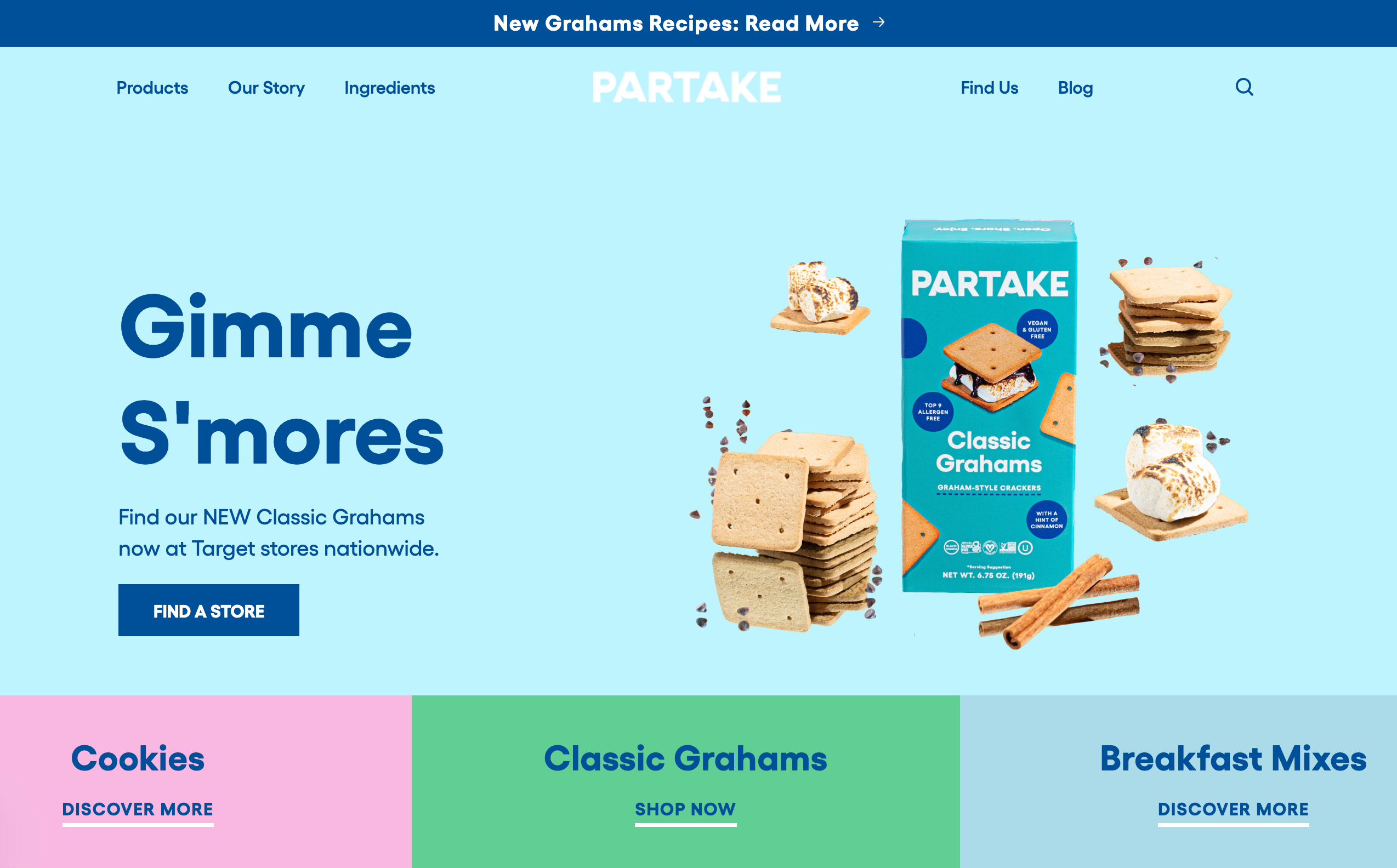Attractive and unique ecommerce website design has always played a key role in a successful online sales and marketing strategy.
In fact, studies have shown that it takes 50 milliseconds for visitors to decide if they’ll stay on an ecommerce site or not. You get only an instant to impress users, which is why website design is so important for your ecommerce business.
Whether you’re about to create your first online store or you’re thinking about redesigning your current site, this guide is for you. Browse examples of great ecommerce websites, tips for choosing the right ecommerce platform, and advice to get your online business looking its best.
4 elements of great ecommerce website design
The best ecommerce websites all have one thing in common: they center the user experience from first visit to post-checkout. There are four main components every ecommerce business should consider when designing a website.
1. Building trust with customers
When someone visits your ecommerce store or website for the first time, they may not know anything about your brand, the quality of your products, or your commitment to making customers happy. Deals might earn their consideration, but they’ll need to trust you before they actually go through with a purchase.
Customer trust is hardest to earn when you don’t have any customers, so you’ll want to incorporate the following trust indicators as you build your website.
Contact information
Include an email and, if possible, a phone number and a mailing address on a Contact page and in the footer of your site. This type of information, along with an about page, helps potential customers feel they’re buying from a real person.
A return policy
A return policy not only makes it easier for people to send back products that don’t satisfy them, it actually increases sales by lowering shopping cart abandonment and instilling the customer with a sense of confidence and trust that they can send back an item if they need to, without any transaction fees.
Not only does Supergoop have a comprehensive returns page and self-directed returns portal, it also boasts its free returns policy on every product page.
Technical certifications
By adding Shopify Payments to your ecommerce website, you’ll have access to advanced features and payment services featuring the latest security technology for protecting your customers’ information. Add graphics or badges to show your security compliance and all the payment methods you accept.
Customer reviews and testimonials
Many ecommerce solutions have app integrations that let you import content into your site. This includes customer photos, your Instagram feed, and even customer reviews. These are signals to potential customers that your brand is trustworthy.
2. Creating a visually compelling experience
Perception is everything when selling your products online. People form their first impression of your ecommerce store in mere milliseconds. Making that impression count rests largely on high-quality images, consistent branding design, smart use of psychological design, and a clear visual hierarchy.
Here are some best practices for each of these elements:
- Photography: Product photography is like an ambassador, sharing the promise of your product online. Shoot product photos on a plain background and in many angles. Lifestyle photos are important to show your product in use and in context within an environment. They also reinforce a brand aesthetic.
- Color: Color is one of the most powerful tools you can use to spark interest and emotion on your ecommerce site. It can also be used to draw attention to specific sections of your website and lead the customer journey. Smart use of color can help with accessibility, too.
- Fonts: While the words you write on your ecommerce site share information, it’s the typography that communicates the emotion behind that information. It’s a good idea to stick to two fonts and create a hierarchy between them. Choose one font as your header or title font and another to be your body font.
- Psychological design and visual hierarchy: Using psychological design principles allows you to influence customer decision making and the path of their eye by strategically placing elements, colors, and text on pages.
Outdoor Voices’ homepage features lifestyle images to communicate its brand aesthetic and an aspirational lifestyle. It focuses on limited fonts for a clean look and a clear visual hierarchy.

3. Focusing on responsive design for mobile and desktop
The average daily time spent on a mobile phone in the US is expected to reach 4 hours and 39 minutes by 2024. Luckily, if you’re building your business with Shopify, your store is already responsive. This means the site is user friendly on different devices and screen sizes, whether customers view it on a desktop, smartphone, or tablet.
When choosing an ecommerce website design based on mobile optimization, it’s best to personally test it to see if you’re happy with the transactional flow. If you’re not, there’s a good chance your customers won’t be either.
4. Designing clear navigation
Your website navigation should help customers find your products quickly and easily. Good navigation also helps improve SEO on your site so you get found in search results.
Stick to only a few menu headers in your top-level navigation. Be clear and direct when labeling these headers—this is no time to be clever. Key headers to include in your top-level navigation could include:
- Shop
- About Us
- Bestsellers
- Contact Us
Additional navigation links can go in your footer—the section at the bottom of your website. Return Policy, Terms of Service, and Contact Us pages can be linked here.
25 ecommerce website design examples (and why they work)
The best ecommerce website design examples are those that consider all the elements above for a clean, appealing, user friendly design that communicates the brand and products clearly. Here are a few ecommerce website examples to inspire your own ecommerce design.
1. Thesus

2. Welly

3. Fred Jourdain

4. MVMT

5. Pure Cycles

6. Verve Coffee Roasters

The online coffee retailer also uses evocative language paired with stylish photography to keep customers on the page. For example, it promises to be “classic and delicious” and delivers on this expectation through evocative word choice, such as “the sweetness of golden marmalade.”
7. Finn

8. Hardgraft

9. Topo designs

10. KETNIPZ

11. Chubbies

12. KITH

13. Personal Fav

14. Satya Organic

15. Beardbrand

16. Kylie Cosmetics

17. Allbirds

18. Tiny Organics

19. Tessemae’s

20. Death Wish Coffee

21. Almond Surfboards

22. Leather Head

23. Pura Vida Bracelets

24. Boba Love

25. Partake Foods

8 best ecommerce website design tips
While you’ll want to design your online store based on your established brand guidelines, there are a few best practices to consider to improve usability and customer experience. Your ecommerce site is the résumé for your online business. Whether you’re a startup or building your fifth ecommerce store, keep these website design tips in mind:
1. Keep it simple
Simple is always key to making more sales in your ecommerce business. The more distractions you put on your ecommerce website (think banner ads, pop-ups, too many colors), the more it takes away from making the sale. A good ecommerce platform will have a number of ecommerce website templates to choose from to help you keep your design streamlined.
2. Express your brand
It doesn’t matter if you’re a photographer, beautician, or dropshipper running an online business. People want to buy from established brands they trust and identify with. Take the time to define your brand and figure out what makes you different from competitors—then apply it to your web design.
3. Use the right platform
Use the best ecommerce platform for your online store. When using a platform like Shopify, you can set up a beautiful store with powerful ecommerce features and sell online quickly. A great ecommerce platform should be flexible and easy to use, allowing you to customize your ecommerce website to your exact needs. You can use Shopify’s online store builder, which offers the functionality to create your own store from scratch.
4. Have empathy
Put yourself in your potential customers’ shoes. How easy is it to navigate your ecommerce website? How does it make someone feel when shopping? How easy is the checkout process? Think about what your customer needs to make a purchase in your store and design it accordingly.
5. Upload high quality images
Images can improve a website’s conversion rate by 40%. But they have to be high-quality. Invest in good product photos and use images from free stock photo websites to help increase the visual appeal throughout the shopping experience.
6. Lead with professionalism
Want to start an online store that builds trust with shoppers? You’ll want to have a professional website. Customers won’t give you their hard-earned money or sensitive information like credit card numbers if it’s anything less.
7. Leverage social proof
When designing your ecommerce site, look for places to show social proof like positive reviews and user-generated content. The more shoppers see the good experiences other people have had with your products, the more likely they’ll be to buy.
8. Focus on checkout
Even if you have a beautiful, innovative ecommerce website design, if checkout is a pain, customers may not buy from you. Make checkout for your ecommerce business simple, straightforward, and fast. Use payment gateways like Shop Pay, Amazon Pay, PayPal, Stripe, and other accelerated payment options to make it as easy as possible for shoppers to buy.
Design a website for your ecommerce business today

When it comes to building a successful ecommerce business, design is one of the most important things business owners and marketers need to consider. After all, your ecommerce store visitors can form an opinion about your site in milliseconds. First impressions matter.
Feature illustration by Rachel Tunstall
Read more
- The Ultimate Guide To Dropshipping (2024)
- AliExpress Dropshipping- How to Dropship From AliExpress
- How To Source Products To Sell Online
- How to Start a Dropshipping Business- A Complete Playbook for 2024
- The 9 Best Dropshipping Websites for Your Online Store
- The 13 Best Dropshipping Suppliers in 2024
- Amazon Dropshipping Guide- How To Dropship on Amazon (2024)
- Product Pages: 16 Beautiful Product Landing Page Examples (2024)
- Lookbooks- How to Use High-Quality Lifestyle Photography to Boost Sales
- How to Optimize Your Images for the Mobile Web
Ecommerce website design FAQ
Can I build an ecommerce website on my own?
Ecommerce website platforms like Shopify make it easy for business owners to build a beautiful and user-friendly website for their online stores, with features like free hosting, custom domains, design templates, and search engine optimization. If you want to build an ecommerce website but have no design or coding skills, an ecommerce platform provides all the tools you need.
How can I improve my ecommerce navigation?
When designing your ecommerce site navigation, stick to a few core pages for your header navigation (Shop, About Us, Bestsellers, Contact), then place any other important links in your site’s footer.
Which is the best platform to build an ecommerce website?
Shopify’s ecommerce platform can help you build an attractive and functional online store with industry-leading ecommerce transaction architecture and a range of design options, including templates and drag-and-drop customization.
How much does it cost to build an ecommerce website?
Building an ecommerce website from scratch can be costly if you have to hire a web design expert or coder. But you can build an ecommerce business quickly and for a relatively small investment to get selling online right away. Many ecommerce platforms offer a free trial so you can play with ecommerce design and use fully customizable templates to build your website. After you’re happy, choose a plan that fits the budget for your ecommerce business.
What’s the best ecommerce website builder?
Shopify is an all-in-one ecommerce website builder to help you get online and sell your products. You can start by choosing from over 100 ecommerce website templates in the Shopify Theme Store. Each is fully customizable, and you can use our site builder to shape your template by choosing a domain name, adding your logo, brand colors, fonts, and more.
You can also support your online store with more than 3,000 apps in the Shopify App Store to help with marketing, sales, customer service, and more.
With secure ecommerce hosting, a streamlined admin dashboard, and unlimited bandwidth, you can set up your ecommerce business quickly and easily. Plus, you have full control over your site’s appearance with the ability to edit your theme’s HTML and CSS.

